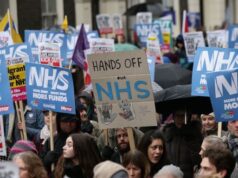Issue: 37
June 2016
This occasional newsletter is researched, written and edited by a group of concerned residents in Ealing, West London who want to preserve our NHS. We view the wholesale engagement of private, for-profit healthcare service suppliers as unnecessary, profligate and dangerous. Process improvement is what is needed in our NHS – not revolution.
500 Acute NHS Beds To Be Axed in North West London Over the Next Four Years
It took an article in the 10 May 2016 issue of the ‘Evening Standard’ to inform us all about the projected butchering of our local hospitals. The so called debt of £1 billion in NHS NW London is apparently to be dealt with by axing 500 Acute beds in our local hospitals by 2020. The beds to be lost would have been for use by both the physically and the mentally ill.
The trio who told the newspaper are the bosses of the NHS Ealing Clinical Commissioning Group, Brent Council and the NHS Imperial Healthcare Trust.
Digging deeper into this bombshell we find that the figures came from the draft NHS NW London Sustainability and Transformation Plan (STP). This draft STP has been hatched in secret by representatives of 31 public bodies including eight NHS CCGs, eight Local Authorities and all the NW London NHS Trusts. The failing 2012 cost cutting ‘Shaping a Healthier Future’ (SaHF) programme does not get any mention whatsoever. Obviously SaHF as a cost cutting vehicle has now been replaced by STP.
The body which created this STP calls itself the NWL Strategic Planning Group (SPG). The SPG has no statutory authority and is not the creation of any Act of Parliament. No public consultation was carried out on the STP or the SPG. I can’t find any evidence of SPG meeting minutes or the draft STP. You might have thought that these documents might exist on the Ealing CCG web site, the Ealing Council web site or the web site of the ‘North West London Collaboration of Clinical Commissioning Groups’, but you would be wrong.
Of course the ‘Evening Standard’ quotes some anonymous NHS spokesperson shoveling out the usual claptrap about not axing beds before alternative services are in place. Well, this never happened when Acute beds were axed from Central Middlesex and Hammersmith Hospitals in September 2014. And I don’t expect it will happen with the new ‘Axe 500 beds’ project.
Are Clinicians the Best People to Make Decisions That Could Put in Danger the Lives and Health of Our Children?
On 25 April 2016 eight senior NW London Paediatricians wrote a letter in support of closing Ealing Hospital’s Acute care for children. On 18 May 2016 Ealing CCG duly endorsed the experts’ view and confirmed closure of all Acute services for children at Ealing Hospital on 30 June 2016.
The first glaring omission in the experts’ letter is the complete lack of any reference to caring for mentally ill children. So much for the parity of esteem for physical and mental health. This unforgivable slight on emergency care for seriously mentally ill children almost invalidates the letter completely. A second glaring omission is that the authors don’t even have the guts to explicitly endorse the closure of A&E facilities for children at Ealing Hospital.
No doubt senior clinicians endorsed or even mandated the closure of the A&E units at Central Middlesex and Hammersmith Hospitals in September 2014. These closures led to an immediate, unprecedented and massive drop in A&E performance across the whole of north west London. And even now, some 18 months since the A&E closures, the A&E waiting times at Charing Cross and St Mary’s Hospitals are amongst the worst in England.
The reality of better clinical care for children in Ealing is rapid access to appropriate physical and mental health competencies for seriously ill children. 4,500 seriously ill children are brought to Ealing Hospital A&E each year. Last year 4,185 of these arrived in the arms of a parent, carer or loved one and not by ambulance. Under the new July 2016 regime these sick children will be triaged by the Urgent Care Centre at Ealing Hospital and then subject to an up to one hour wait for Patient Transport Services (PTS) to take them to a remote hospital A&E outside Ealing. The other option being proposed is the Children’s Acute Transport Service (CATS). CATS median response time is 75 minutes. Only when the child reaches this out of borough hospital will the possibility of expert treatment become a reality. It’s not clear how the parent/carer/loved one will get to the remote hospital, especially if it’s 4am for example. None of this is clear in the letter from the senior medics or any NHS patient literature in print or in draft.
No doubt the senior medics who admit to designing these new children’s Acute services and who signed the letter are experts in their fields and have impeccable motives. However do we as a society allow nuclear scientists to push the nuclear weapon button? To use another analogy – from my own career – when you are designing a computer system you start off with discovering the users’ requirements. The users’ requirements in this case are quite clear. The 68,000 Ealing children and their parents/carers/loved ones require a complete children’s care service in Ealing providing 24 hour A&E, in-patient beds and specialist Peadiatric and mental health services. The obvious location for this across the 21 square miles of the borough is within the existing facility at Ealing Hospital in Southall.
Dr Anne Davies, Dr Michele Cruwys, Dr John Hutchins, Dr Hermione Lyall, Dr Kingi Aminu, Kay Larkin, Katrina Warkcup and Nathan Askew – I do hope all your service design efforts for our local children work out well. I do realise it would have been very difficult for you all to say explicitly ‘…we had to save money and what we’ve come up with is the least worst option’. However you didn’t. No doubt you might have gained citizens’ respect if you had said that. If children’s Acute services for Ealing children take a turn for the worse at least we’ll know at whose doors to lay the blame.
‘A Hospital is Not Always the Best Place to Treat People’
We have heard and read this somewhat asinine assertion a number of times emanating from some anonymous NHS spokesperson. In response to this a few questions come to mind. They include:
+ So what?
+ What has it to do with the number of hospital beds we need?
+ Is the statement in actual fact a gutless replacement statement for ‘hospital beds are very expensive and we have to close 100s/1,000s of them because the Government refuses to pay for them’?
Allied to the ‘not always the best place’ assertion is another claim that hospital beds can be replaced by out-of-hospital treatment at home or close to home in the community. However there is little or no evidence that this out-of-hospital approach provides significant cost savings. For example the 2012 ‘Shaping a Healthier Future’ (SaHF) programme has apparently been implementing this bed loss/out-of-hospital replacement approach for over three years in NW London. However the SaHF mavens have yet to claim anywhere, anytime that there have been any resultant cost savings.
With people living longer more elderly people will need treatment/care/surgery that only hospitals can provide.
The number of people in England detained under the 1983 Mental Health Act is rising. It has risen by 30% over 10 years. 58,400 Sectioned patients needed hospital beds in 2014/15 – up 10% on 2013/14.
Government figures in September 2015 stated that 68,560 households in England were living in bed and breakfast, hostels, refuges, supported lodgings and self-contained annexes. The number of families with children in bed and breakfast accommodation has risen by 45% in just one year. Secondary/hospital-type care and treatment for all these people is impossible ‘at home’.
The number of care home beds declined by 1,500 in the year ending September 2015.
Ealing Council’s 2012 plans for building new homes will add 12,407 new homes and 30,000 new residents in Ealing by 2026. Residential development at one site alone in Southall will house some 9,000 new residents.
In conclusion, England lags behind many countries in the number of hospital beds per head of population. Locally the population continues to grow. The number of people requiring hospital beds is rising. The number of care home beds is declining and this will do nothing to reduce bed blocking levels in hospitals. There is no convincing evidence that there are any significant cost savings achieved by replacing hospital care with home care or care in the community (whatever that might be).
‘Home is Not Always the Best Place to Treat People.’
Exploring NHS Myths
+ Priority of esteem for the physically ill and the mentally ill.
NOT TRUE
13% of the NHS annual national budget is spent on mental health treatment. Mental health needs make up 28% of the NHS burden of illness.
+ There are increased attendance levels at hospital A&Es.
NOT TRUE
NHS figure show that nationally in the 119 week up to 31 July 2015 all hospital A&E attendance levels variously varied from the median by 13.5% below to 7.1% above.
+ The best way to measure A&E performance is to lump together all A&E patient treatment performance data and Urgent Care Centre treatment performance data.
NOT TRUE
Of greatest interest and relevance to all of us is the treatment of those who are rushed to hospital with serious injuries or illnesses. The NHS labels these patients as A&E Type1s.
In north west London although Type1 attendance levels have remained the same for over three years, rapid treatment has been elusive. Waiting times for Type1s extended dramatically immediately following the closure of two A&Es in September 2014. It has never really improved since then. In January 2016 attempts to treat 95% of Type1s within four hours (the national target) failed miserably. At Hillingdon, Northwick Park and Charing Cross hospital A&E Type1 performance was below 70%.
Colin Standfield of Save Our Hospitals digs out this Type1 data which is collected but not trumpeted by the NHS. What the NHS trumpets is treatment performance figures for A&E Type1, Type2, Type3 and Urgent Care Centre patients – all lumped together. The implication is that the NHS has the same interest in how fast patients with indigestion are treated as it has with patients with life threatening injuries or illnesses. However a cynic or realist might observe that NHS bosses just don’t want us all to know how it is failing the seriously ill in the provision of hospital A&E services.




